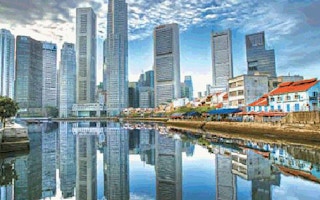We know that the planet is warming up and the human population is growing, raising our demand for resources. The combination of these factors is why the battle against climate change will be decided in cities, particularly cities in the Asia-Pacific.
To continue reading, subscribe to Eco‑Business.
There's something for everyone. We offer a range of subscription plans.
- Access our stories and receive our Insights Weekly newsletter with the free EB Member plan.
- Unlock unlimited access to our content and archive with EB Circle.
- Publish your content with EB Premium.
These urban centres are triple ‘hot spots’: they face rising temperatures, increasing populations and escalating consumption.
To tackle these challenges, we need practical and successful ideas that can easily be replicated.
At the 4th Sustainable Cities Conference last week in Singapore, I discussed ways for Singapore and Hong Kong, already recognised as innovative cities in tackling these problems, to become even greener and establish themselves as leaders in creating sustainable city models for the Asia-Pacific.
Most experts agree that 8 mega trends have emerged and can be identified:
- Economic global power is shifting from Europe and North America to Asia and Latin America.
- Urban populations are increasing, with an ageing population in many countries.
- Greenhouse gas emissions keep rising, but reductions are not happening as planned, or as fast as necessary.
- Environmental degradation jeopardises people’s quality of life
- The global middle class is rapidly expanding, increasing consumption levels; as a result, urban sprawl is occurring in many places
- The world is running out of some resources while energy, water and raw materials are being wasted
- There is more competition between cities to attract investment and a skilled workforce
- More municipalities are focusing on low carbon mobility, renewable energy, waste management and the reintegration of biodiversity in the urban context. Some cities even have ambitious targets such as being ‘climate neutral’ or aim to be the ‘greenest city’ in the region.
Looking at the necessary infrastructure for green cities, I spoke about ways which could transform the ‘little red dot’, which Singapore is known as, into a truly green dot by re-engineering cities to achieve zero waste by utilizing low carbon construction systems, reusing building components and activating biomass.
What are the principles for transforming Asian cities? Let’s take Singapore as an example.
Firstly, we need to focus on the problem of rising consumption. This requires a shift in values to encourage more careful consumption by our growing urban middle-class. Waste minimisation and resource recovery programmes are part of this, but this also requires behaviour change of the consumer, which is the biggest challenge.
Luckily, Singapore is blessed with good leadership and plenty of champions who work tirelessly on the green city agenda. Singapore is leading the way in water management, district cooling, integrating biodiversity and vertical greenery into the urban context and in developing affordable public transport systems. Making public transport the backbone of the city’s development has proven to be a suitable strategy.
Secondly, we need to focus on biomass (plant to food waste), through anaerobic digestion and composting, to produce energy and fertiliser.
Due to cloud cover and a lack of wind, solar and wind power are lacking in cities close to the equator, such as Singapore. Where there is a relatively high amount of green space and many people concentrated at one point, there is lots of biomass to be collected and used. We cannot look at waste in isolation but must see it as part of integrated urban planning.
Urban farming is particularly exciting as it allows cities to produce their food locally, without the large greenhouse gas emissions from transporting and processing food.
Thirdly, we need more ambitious targets in greenhouse gas emissions. The target of 11 per cent reduction set by Singapore is too modest. Instead of just aiming to achieve minimum compliance, there must be a more integrated and ambitious approach with a greater sense of urgency.
Fourthly, Singapore could retrofit its public housing blocks and precincts rather than demolish them, which risks losing existing community ties and a sense of identity, and transform them into districts suitable for an ageing population.
In this retrofitting exercise, building above existing buildings, through urban infill, has gained momentum. Existing buildings are retained and integrated within the overall envelope or parcel of land, and new developments are spanning over it. This method of making existing cities more compact is making air rights more important and planning more three-dimensional.
By recognising that cities are more than just buildings, and combining these four approaches, we will bundle our multidisciplinary efforts to create sustainable cities of the future.
Professor Steffen Lehmann, is Director of the China-Australia Centre for Sustainable Urban Development, CAC_SUD, a leading think-tank for research and consultancy on urbanisation in the Asia-Pacific region. He is editing a forthcoming book, ‘Low Carbon Cities. Transforming Urban Systems’.









